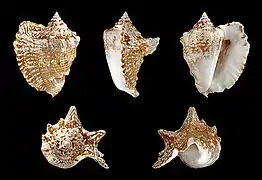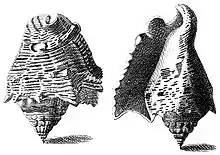Lobatus raninus
Lobatus raninus, common name the hawk-wing conch, is a species of medium to large sea snail, a marine gastropod mollusk in the family Strombidae, the true conchs.[1]
| Hawk-wing conch | |
|---|---|
 | |
| Five views of a shell of Lobatus raninus (Gmelin, 1791) | |
| Scientific classification | |
| Kingdom: | Animalia |
| Phylum: | Mollusca |
| Class: | Gastropoda |
| Subclass: | Caenogastropoda |
| Order: | Littorinimorpha |
| Family: | Strombidae |
| Genus: | Lobatus |
| Species: | L. raninus |
| Binomial name | |
| Lobatus raninus (Gmelin, 1791) | |
| Synonyms[1] | |
|
List of synonyms
| |
Shell description

The maximum recorded shell length is 121 mm[2] or up to 130 mm.[3] Like other species in the same genus, Lobatus raninus has a robust, somewhat heavy and solid shell, with a distinct stromboid notch. The body whorl is dorsally ornamented by characteristic coarse spiral ridges.[3] The posterior expansion of the flaring outer lip is always lower than the spire.[3] The color is brownish, with several disperse white spots. Both inner and outer lips are cream or white.[3]
Phylogeny
| |||||||||||||||||||||||||||||||||||||||||||||
| A simplified version of the phylogeny and relationships of Strombidae according to Simone (2005)[4] |
| ||||||||||||||||||||||||||||||||||||||||||||||||||||||||||||||||||||||||
| Phylogeny and relationships of Eastern Pacific and Atlantic Strombus species, according to Latiolais and colleagues (2006)[5] |
The phylogenetic relationships among the Strombidae have been mainly accessed on two occasions, using two methods. In 2005, Simone proposed a cladogram (a tree of descent) based on an extensive morpho-anatomical analysis of representatives of Aporrhaidae, Strombidae, Xenophoridae and Struthiolariidae, including L. raninus (there referred to as Tricornis raninus).[4]
With the exception of Lambis and Terebellum, the remaining taxa were previously allocated within the genus Strombus. However, according to Simone, only Strombus gracilior, Strombus alatus and Strombus pugilis, the type species, remained within Strombus, as they constituted a distinct group based on at least five synapomorphies (traits that are shared by two or more taxa and their most recent common ancestor).[4] The remaining taxa were previously considered as subgenera, and were elevated to genus level by Simone in the end of his analysis. The genus Tricornis (now considered a synonym of Lobatus),[1] in this case, only included T. raninus (now considered a synonym of Lobatus raninus).[1][4]
A different approach, this time based on sequences of nuclear histone H3 and mitochondrial cytochrome-c oxidase I (COI) genes was proposed by Latiolais et al. (2006). The phylogenic relations of (32 analyzed) species that used to belong or still belong in the genus Strombus and Lambis are shown below:[5]
Distribution
This species is distributed in the Caribbean Sea, the Gulf of Mexico and the Lesser Antilles.
Ecology
- Habitat
S. raninus lives near seagrass beds, usually in shallow water.[3] The minimum recorded depth is 0.3 m; the maximum recorded depth is 55 m.[2]
- Feeding
Like other species of the genus Strombus, S. raninus is known to be a herbivore.
References
- Bouchet, P. (2010). Lobatus raninus (Gmelin, 1791). Accessed through: World Register of Marine Species at http://www.marinespecies.org/aphia.php?p=taxdetails&id=531851 on 2011-03-21
- Welch, J.J. (2010). "The "Island Rule" and Deep-Sea Gastropods: Re-Examining the Evidence". PLoS ONE 5(1): e8776. doi:10.1371/journal.pone.0008776.
- Cervigón, F. et al. (1993). "FAO species identification sheets for fishery purposes. Field guide to the commercial marine and brackish-water resources of the northern coast of South America". Rome, FAO. 513 p.
- Simone, L. R. L. (2005). "Comparative morphological study of representatives of the three families of Stromboidea and the Xenophoroidea (Mollusca, Caenogastropoda), with an assessment of their phylogeny" (PDF). Arquivos de Zoologia. São Paulo, Brazil: Museu de Zoologia da Universidade de São Paulo. 37 (2): 141–267. ISSN 0066-7870. Archived from the original (PDF) on 2012-03-05.
- Latiolais J. M., Taylor M. S., Roy K. & Hellberg M. E. (2006). "A molecular phylogenetic analysis of strombid gastropod morphological diversity". Molecular Phylogenetics and Evolution 41: 436-444. doi:10.1016/j.ympev.2006.05.027.PDF.
- Rosenberg, G., F. Moretzsohn, and E. F. García. 2009. Gastropoda (Mollusca) of the Gulf of Mexico, Pp. 579–699 in Felder, D.L. and D.K. Camp (eds.), Gulf of Mexico–Origins, Waters, and Biota. Biodiversity. Texas A&M Press, College Station, Texas
| Wikimedia Commons has media related to Lobatus raninus. |